
Th
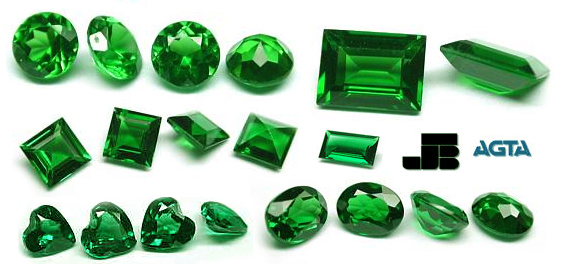
Emerald History: Green beryls are called emerald, blue aquamarine. Green emerald expresses faithfullness and continuity. The coloring agent is chrome, sometimes vanadium. The color is very stable against light and heat. The color distribution is often irregular; a dark green is most desired. Only the fine specimens are transparent. Often the emerald is clouded by inclusions. These are not classified as faults, but as evidence to the genuineness of the emerald as compared with synthetices.
Physical Properties: Emerald Color: Emerald Green, green and yellowish green; Emeralds Moh's Hardness: 7.5-8; Emeralds Density: 2.67-2.78; Emerald Chemical Composition: Aluminium Berrylium Silicate; Emeralds Transparency: Transparent to Opaque; Emeralds Refractive Index: 1.565-1.602; Emeralds Dispersion: 0.014; Emeralds Pleochroism: Definite; green, blue, blue green to yellow green.
Emerald Jewelry | Rings: emerald ring.
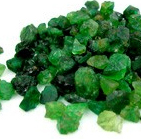
Emerald
is
the green variety of the mineral beryl and one of the most highly
prized all gems. Emerald is the birthstone for May and the zodiac
stone for those born under Cancer's sign. Throughout history emerald
has been one of the most desired and coveted of gems. Associated with
Venus, the Roman goddess of love, the emerald was believed to bestow
upon the wearer faithfulness and unchanging love. Emerald belongs to
the gem family beryl. Colombia, Brazil, and Zambia are the major
producers, but there is an increasing shortage of fine emerald, and
producers are having trouble keeping up with world demands.
Emerald
Color:
The finest quality emerald has the color of fresh young green grass-
an almost pure spectral green, possibly with a very faint tint of
blue. The highest quality emeralds have medium tone and are bright
green with good color saturation. Color distribution should be uniform.
Emerald
Saturation
(color purity) is the brightness or vividness (dullness or drabness)
of the color. It refers to the degree to which the hue is hidden by
brown or gray. Colors with minimum amount of brown or gray are
described as vivid or strong. For color purity GIA uses saturation
and AGL uses intensity. Saturation can be "highly pure" and
"slightly brownish or grayish". Our emeralds are
"slightly brownish or grayish."
Emerald Hue: refers to the basic colors of blue, gren, yellow, orange, red, purple and violet. All emeralds exhibit some other colors in addition to their basic green color. To determine the hue, look for the dominant color in the face-up view. When you move the stone in different directions you see the different colors.
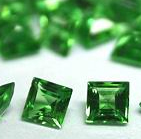
Emerald Tone: Refers to the depth of color (light or dark). The lighest possible tone is colorless. The darkest is black. Tone is another word for the degree of lightness or darkness. Judging the tone of a stone is difficult because it doesnot display a single, uniform tone. To judge the tone of a stone, examine it face-up and look for areas of light and dark. Columbian emerald is a deep green with a very slight blue undertone and is considered the finest. African emerald is also a nice shade of green with a blue undertone with a slight darkening effect which makes it slightly less valuable than columbian. Emerald can have tones: "light-medium," "medium," "medium-dark," and "dark". We prefer emeralds with medium tones in rings & emerald jewelry.
Emerald Clarity: Clarity refers to the absence of internal flaws or inclusions. Type and placement of flaws are also very important. Flawless emeralds are so rare that inclusions are expected in genuine emerald. When there aren't any inclusions, one wonders if the stone is in fact an emerald. So placement of flaws are important when buying a emerald in rings.
Emerald Cut: A good cut will enhance stones natural beauty to the fullest. A poor cutter make may make the same stone less desirable, because a poor cut will significantly reduce the vividness and alter the depth of the color (saturation), usually producing a stone that is too dark. Flaws are very common in emeralds and that is why cut of an emerald is important in not allowing these flaws to penetrate deep into the gem.
Emerald Value: Emeralds which are well cut, pure deep green and are moderately clean (flaws placement is good) are most valuable in rings.
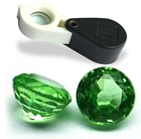
Emerald Size: The common unit of measurement for stones is weight, expressed in carats and decimal parts thereof. Also, remember again not to confuse weight with size. Some stones weight more than others bacause stones have different density. Size of stone which can be diameter, or length and width is expressed in millimeters. Our stones are not cut deep to gain weight but are well cut emeralds offering you maximum size.
Taking
Care of Emerald Jewelry?
When you store jewelry, protection from theft and damage should be a
prime consideration. A jewelry box can protect pieces from damage if
they are stored individually, but it is one of the first places
burglars look. Emerald should never be cleaned with an ultrasonic
cleaner but with a soft cloth. Emeralds should be wrapped separately
in soft material or placed individually in pouches. Wear jewelry
after you are dressed up. Have a professional check your jewelry
every couple of years to check the setting as well as the stones.
Important Considerations: Both intensity and tone of color can be significantly affected by the proportioning of the cut. In other words, a good gem cutter working with a fine stone will be able to bring out its inherent beauty to the fullest. A poor cutter make may make the same stone less desirable, beacause a poor cut will significantly reduce the vividness and alter the depth of the color (saturation), usually producing a stone that is too dark. In emeralds a shallow cut might bring more color saturation than a deeper cut.
Step-Cut Diamonds - Stones whose outlines are either squarish or rectangular and whose facets are rectilinear and arranged parallel to the girdle are called as step-cut or trap-cut stones. These stones often have their corners truncated, creating an emerald cut with an octagonal outline. This is done because sharp corners are points of weakness where a diamond may break or fracture. Instead of a culet, step-cut stones have a keel running throughout the length of the pavilion. Like other fancy shaped diamonds, emerald cut diamonds can come in a variety of length to width ratios. The most popular and classic outline of emerald cut diamonds are about a value of 1.5.
Because both the pavilion and crown are comparatively shallow, step cut stones are generally not as bright and never as fiery and sparkling as brilliant cut stones, but rather accentuate a diamond's clarity (as even the slightest flaw would be very highly visible), whiteness, and lustre (and therefore good polish is recommended).
Due to the current demand for brilliant and brilliant-like cuts, step cut diamonds suffer somewhat in value; stones that are deep enough may be re-cut into more popular shapes. However, the step cut's rectilinear form were very popular in the Art Deco period. Early antique jewelry of the period features step-cut stones prominently, and there is a market in producing new step-cut stones to repair antique jewelry or to reproduce it. The slender, rectangular baguette (from the French, resembling a loaf of bread) was and is the most common form of the step cut: today, it is most often used as an accent stone to flank a ring's larger central (and usually brilliant-cut) stone.
Square step cuts whose corners are not truncated are known as carré; they are also characteristic of antique jewelry. They may resemble the square-shaped Princess cut in passing, but a carré's lack of fire and simpler facets are distinctive. They may or may not have a culet. In Western jewelry dating to before the advent of brilliant-type cuts, very shallow step-cut stones were used as lustrous covers for miniature paintings: these are known in the antique market as portrait stones. Characteristic of Indian jewelry are lasque diamonds, which may be the earliest form of step cut. They are flat stones with large tables and asymmetric outlines.
Other forms of the step cut include triangle, kite, lozenge, trapeze, and obus shapes.
Enhancements: Unpolished gemstones are typically very rough. Looking at gemstones straight from the mine, they might be mistaken for pebbles or gravel.
Nearly all gemstones available on the open market have been "enhanced" (i.e. something has been done to make them look better). Gemstones that have not been enhanced are very rare and command extravagant prices.
There are many methods of enhancing gemstones. Some of the most common enhancement treatments are described below. For more information on gemstone enhancements, visit the American Gem Trade Association website
The use of heat to enhance the color of some gemstones is a common practice around the globe and has been going on for centuries. It is part of the standard polishing and finishing process for many gemstone varieties, including aquamarine, citrine, amethyst, sapphire, ruby and tanzanite, and is accepted by the jewelry industry and the American Gem Trade Association.
The enhanced color of heat-treated gemstones is permanent and does not require special care. Aquamarine, citrine, amethyst, sapphire, ruby and tanzanite gemstones offered by Blue Nile have been heat treated.
Colorless oil, wax and resin are used to improve the clarity of some gemstones. The colorless oil, wax or resin is infused into surface-reaching fissures (called inclusions) to improve the stone's appearance. This process began centuries ago by gemstone merchants who found that immersing emeralds in clear oil or waxes made them look clearer to the unaided eye. Today, almost all emeralds are treated in this way. Gemstones with colorless oil, wax or resin enhancement, including emeralds, can be harmed if handled roughly. Recommended special care for such gemstones is avoidance of sudden temperature changes, steaming, chemicals and ultrasonic exposure.
Emeralds offered by Sndgems.com may have been treated with colorless oil, wax or resin.
Emerald Jewelry
Gemstone Rings:
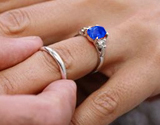
When you store sapphire jewelry like rings, protection from theft and damage should be a prime consideration. Sapphire can be cleaned with an ultrasonic cleaner or with a soft cloth. Sapphires should be wrapped separately in soft material or placed individually in pouches. Wear jewelry after you are dressed up. Have a professional check your ring every couple of years to check the setting as well as the stones.

American Gem Trade Association (AGTA) is one of the most recognized authorities on gemstone grading. Enhancements that are not permanent are considered to deceive the customer. Gemstone enhancements considered acceptable should be permanent; not immitated (substitutes); and color altered.
Ruby is one of the most expensive gem, large rubies being rarer than comparable diamonds. The largest cuttable ruby weighed 400 carat and was found in Burma. Modern brides are embracing rings that highlight richly hued rubies with diamonds. Rings with rubies and diamonds in platinum expresses a woman's unique personality. We have an inspirational collection of ruby rings such as ruby engagement rings, ruby wedding rings and anniversary rings. Add more sparkle with our accompanying ruby earrings, ruby bracelets and pendants. Look for a rich red color ruby with a medium shade rings with ruby. View Ruby Rings | Learn About Rubies.
Emerald Education
Emerald in Rings: Looking for emerald in rings ? John F. Kennedy gave his future bride Jacqueline Bouvier a 2.88 carat diamond and emerald engagement ring from Van Cleef & Arpels. The name emerald derives from Greek smaragdos and means green stone. Emeralds are formed by rising magma & metamorphism. Our emerald jewelry collection includes rings like emerald diamond rings, emerald engagement rings, emerald anniversary rings, emerald wedding bands & three stone rings. View Emerald Rings | Learn About Emeralds.

Why Buy From Us | References | Site Security | Guarantee | Return Policy | Buyer's Tips | FAQ | Site Map Product Education | Live Online Help | Search Our Website | Customer Service | Contact Us | Payment Options | Sales TaxShipping Charges | Service Center | Order Tracking | Platinum Facts | Ring Sizing | Engraving Options | PolishingHow To Order | After Sales Service | Legal | Terms & Conditions | Disclaimer | Product Policies | Security

Emerald in Rings | Emerald Anniversary Rings | Emerald Engagement Ring | Emerald Eternity Ring | Emerald Diamond Rings
| Emerald Diamond Three Stone Rings | Emerald Earrings | Emerald Bracelets | Emerald Pendants
Emerald Education | Emerald Color | Emerald Clarity | Emerald Cut | Emerald Properties | Emerald History
Anniversary Rings | Engagement Rings | Diamond Rings | Sapphire Rings | Ruby Rings | Eternity Rings | Wedding Rings
Emerald Diamond Earrings | Emerald Diamond Pendants | Emerald Diamond Bracelets